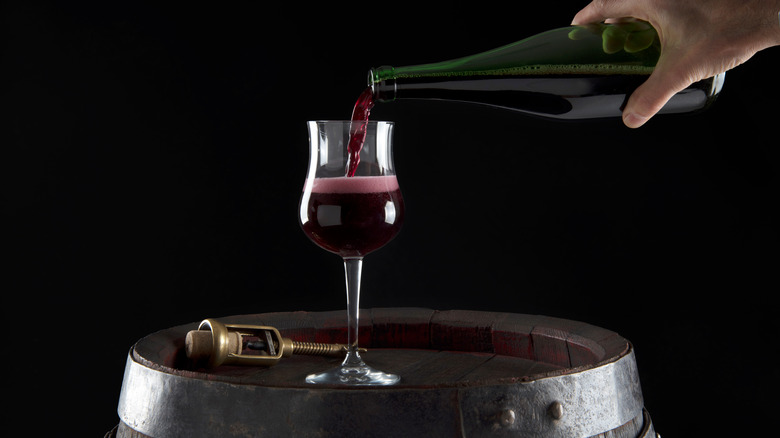The Italian Wine You Should Be Drinking With Prosciutto
Everyone knows the beloved Italian sparkling wine Prosecco, and while its place at cocktail hours and dinner tables isn't in question, it's time to make room for another sparkling Italian wine of a darker hue — Lambrusco.
Liquor.com reports that Lambrusco is a sparkling red wine that is most frequently made in the Northern Italian region of Emilia-Romagna. According to Delish, some historians believe that the Lambrusco grape was one of the first used to make wine in Italy, and it remains the country's most exported wine. The wine is made using varieties of a grape that goes by the same name. While almost always a sparkling wine, its flavor ranges from highly dry to highly sweet and is sometimes served as a rosè. Usual Wines says that even though it is a popular wine, many first encounter it in its hyper-sweet form and are unaware of the variety within the classification. We recommend Lambrusco as a great wine to serve or give as a gift around the holidays, thanks to its versatility. It can be a dry, earthy palette cleanser with dinner or a cranberry-tinged digestive to settle in with. Its sparkling nature also makes it a great option to add to cocktails.
Lambrusco helps cut prosciuttos fattiness
When oenophiles get together to talk about wine, they will often bring up the terroir of a wine (via Wine Folly). This is usually meant to refer to a wine's characteristics that are unique to where the grapes were grown. You can think of it as a wine's regional qualities. Lambrusco just so happens to be the perfect pairing with a beloved food from the same region — prosciutto di parma. According to Wine Enthusiast, the subtle tannins of a good Lambrusco help to cut the "King of Hams'" strips of mouth-watering fat (via Eataly). It also helps offset the saltier, leaner flavor for which this particular prosciutto is best known.
Because prosciutto is an air-cured ham, it has a terroir of its own. Wine and Dine Passport notes that the weather in different towns and regions can affect the flavor of the ham. While these qualities aren't obvious to the average consumer, it is pronounced enough that prosciutto di Parma has its own designation to separate it from its most popular rival, prosciutto di San Daniele. Eataly points out that Lambrusco may be best for prosciutto di Parma, but there might be better options for those produced in San Daniele in the high alps or even from nearby Modena.

